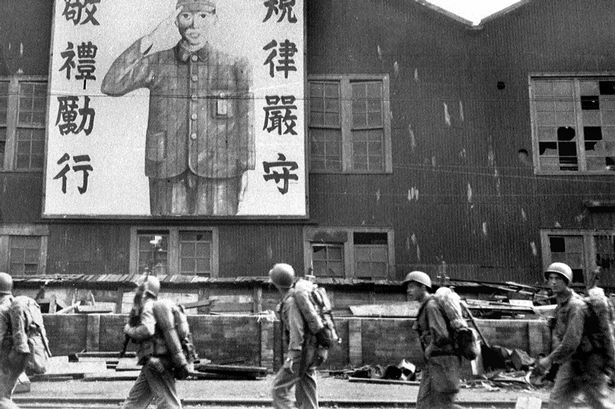Reg Draper was a stores assistant on Royal Navy battleship HMS Duke of York, which was sailing off the coast of Japan in August 1945 when the country surrendered. JAPAN – SEPTEMBER 01: World War II. Pacific front. The American Marines in Sasebo (near Nagasaki) going past a Japanese poster about the army, September 1945. (Photo by Roger Viollet via Getty Images)(Image: (Photo by Roger Viollet via Getty Images))
JAPAN – SEPTEMBER 01: World War II. Pacific front. The American Marines in Sasebo (near Nagasaki) going past a Japanese poster about the army, September 1945. (Photo by Roger Viollet via Getty Images)(Image: (Photo by Roger Viollet via Getty Images))
A 100-year-old Second World War veteran who witnessed the official ceremony marking Japan’s surrender has spoken of his memories 80 years on from the end of the conflict.
Reg Draper was a stores assistant on Royal Navy battleship HMS Duke of York, which was sailing off the coast of Japan in August 1945 when the country surrendered.
His memories of his time at sea include rationing out a daily tot of rum for every member of the crew and coming off worst in a hockey tackle with Queen Elizabeth II’s future husband.
Mr Draper, who grew up in Leeds, West Yorkshire, said the crew cheered when news of Japan’s surrender came from the captain.
He said: “All the ships mustered in Tokyo Bay with the USS Missouri, which was the American ship, and it was on the Missouri where they signed the peace treaty.
“Then we all came back down to Australia and we went and celebrated – we went down to Tasmania and everybody had four days leave in Hobart.
“Everybody wanted to take us to their home and there were a couple of dances in the dance hall.”
Mr Draper witnessed the signing of the Japanese instrument of surrender document firsthand when he went on board the USS Missouri to assist his friend, the ship’s official photographer.
The 80th anniversary of Victory over Japan Day is being marked on Friday with a commemorative event organised by the Royal British Legion at the National Memorial Arboretum.
Mr Draper is planning to watch the ceremony on television from his home in Elton, Cheshire.
He volunteered for the Royal Navy on his 18th birthday and said the worst part of joining up was having all his teeth removed after a medical examination found he had problems with his gums.
He completed his training at the Butlins holiday camp in Skegness and was sent to HMS Ambrose, on a submarine base in Dundee, Scotland, before serving on HMS Duke of York.
One of his duties on ship was rationing out the rum for everyone to have an 11am tot.
Chiefs and petty officers were served theirs neat, while the rum would be watered down for the rest of the crew, he said.
“I’ve drunk Navy rum since I’ve joined up, whenever I could,” Mr Draper said.
Asked if that had contributed to his long life, the 100-year-old said: “Well, that’s the only thing I put it down to.”
Mr Draper served on HMS Duke of York when it carried out Arctic convoys to deliver supplies to Russia, and in 1945 when it sailed to Sydney, Australia, before joining the East Indies Fleet.
He said: “We started going up to the islands, kicking the Japanese out of the islands as we went.”
Japan surrendered on August 15 1945 after the US dropped atomic bombs on the cities of Hiroshima and Nagasaki earlier in the month.
Mr Draper said: “We didn’t hear much about it until it got to the captain.”
HMS Duke of York was escorted by two Royal Navy destroyers including HMS Whelp – which Prince Philip, the late Duke of Edinburgh, served on as first lieutenant.
Mr Draper said he had a lasting memory of Philip coming on board when the ship was docked.
He said: “We used to have deck hockey on the quarter deck and it was murder playing deck hockey.
“He knocked me over once and then the next time he came round he hit me, there’s still a mark there, he gave me a clout with his hockey stick.
“He came to see me just to see how I was. They just put a stitch in and it was alright.”
The pair met again years after the war, when Mr Draper was in the Royal Navy Reserves and training sea cadets in Wirral and Cheshire for the Duke of Edinburgh awards.
He said Philip saw his medals and remembered he had been part of the crew which escorted his ship, but there was no mention of the hockey games.
Mr Draper turned 21 on the return journey from Japan, with more than 2,000 people on board the ship because they were carrying prisoners of war home.
The father-of-two, who went on to work as an insurance salesman, said it took time to adjust back on dry land.
He said: “When we went through the Bay of Biscay at one time it was that rough that the ship’s bows would go 24ft up, 24ft down, just like that.
“You get used to it. Especially if you’re in your hammock, it rocks you to sleep.
“One of the most comfortable sleeps I’ve had is in a hammock!”


AloJapan.com